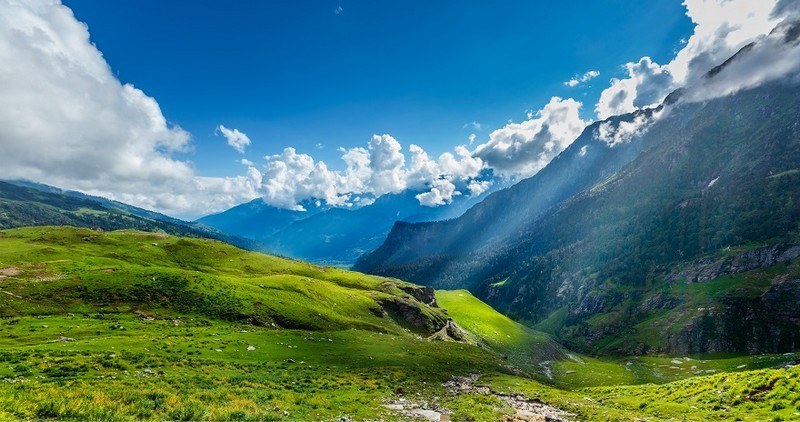
Banjar Valley is situated in Kullu district in the state of Himachal Pradesh, India. It is situated at the height of 1356 metres (4515.48 feet) from sea level. It is a part of Seraj region that extends from Jalori pass till Shikari Devi in Janjehli. Tirthan river is major river of Banjar along with the tributary Pushpabhad flowing from Jalori pass through Jibhi. It is located at the confluence of these two rivers. Banjar is one the tehsil of Kullu district. 'Banjar mela ' is the prominent fair of Banjar valley. A dialect of Kullavi called Seraji is spoken here and the people are also called Serajis.
The Tirthan valley is also a part of Banjar region with Banjar town being the main marketplace in Tirthan Valley. The Tirthan valley is the main gateway to the Great Himalayan National Park (GHNP). Actually, without the national park, the secluded valley would have probably remained unknown. The name of the valley comes from the Tirthan River that flows from Tirth, its origins located in the GHNP, and ends at Larji in the Beas river. Compared to other destination in Himachal, the valley is still well preserved and offers the perfect environment for those who are looking for a peaceful holiday.
Program (4D 4N)
-
1
Gearing Up... Meetup at the boarding point. Board the Bus and enjoy the overnight journey to Jibhi. Jibhi is a little known scenic hamlet in the Banjar Valley of Himachal Pradesh. Lets gear up and start the drive towards our first destination point with picturesque views.
Jibhi is a little-known village in the Banjar Valley or Banjar Valley of Himachal Pradesh. The drive through this highway is extremely scenic with the river, Beas flowing along the gigantic Himalayan ranges which provide for some breathtaking views. This drive alone could be worth the entire journey. The ancient architecture of Himachal Pradesh’s Banjar Valley is striking, and their intricate carvings and cantilevered balconies blend seamlessly with the landscape. A short drive from picturesque Jalori Pass making it a good base for hiking, birding, fishing, and enjoying the outdoors.
-
2
Explore JibhiWe have reached Jibhi in the morning. Check-in to the Cottage and grab a good and filling breakfast while exploring the local edges of the beautiful Cottage which is located between the hills and green forests. Take some rest, freshen up and we're set to explore Jibhi. Heading back to the cottage wouldn't be disappointing as we will have a bonfire and dinner ready at your disposal.
Chehni or Cheni Kothi is situated at Chehni village of Banjar valley in Kullu Manali. Chehni is famous for its twin tower temples. The 350-year-old Chehni Kothi is one of the tallest fort-towers in Himachal (between six and 11 storeys high, depending how you count them. There's a temple inside the tower. Another similar, less high, tower stands nearby and there is also said to be a 400m-long escape tunnel (now closed).
The temple is surrounded by lush green trees and blooming flowers that makes the place more pristine. Since the temple lies at an elevation, the view from here is mesmerizing giving a bird’s eyes view of the whole place.
The Jibhi Waterfalls is hidden inside the forest that cannot be seen until you are well inside the dense forest. The gushing of water flows like music and makes the whole place enchanting. Small wooden bridges are built near the waterfall that provides a picturesque view of the place.
-
3
Prepare yourself for a drive to Jalori Pass. We then trek further to a Viewpoint from where you can see a stunning 360-degree view of the Great Himalayas. We will now further trek to the Serolsar Lake to spend some more time between the crawling clouds. Here you will get infinite opportunities to click pictures with the mountain peaks at your background. Visit nearby temple etc. we will also go to the sunset point to enjoy the evening.
This evening is full of peaceful environment, free of annoying noises of cities and high time to enjoy bonfire on the top of mountains and beneath the stars. After that all is set to enjoy your night in tents.
-
4
The Great Himalayan National Park is a habitat to numerous flora and more than 375 fauna species, including approximately 31 mammals, 181 birds, 3 reptiles, 9 amphibians, 11 annelids, 17 mollusks and 127 insects. They are protected under the strict guidelines of the Wildlife Protection Act of 1972; hence any sort of hunting is not permitted. June 2014, the Great Himalayan National Park was added to the UNESCO list of World Heritage Sites.
The UNESCO World Heritage Site Committee granted the status to the park under the criteria of "outstanding significance for biodiversity conservation“. Rock climbing, river crossing and abseiling are present in the ecozone of the Great Himalayan National Park which can be enjoyed during our visit.



